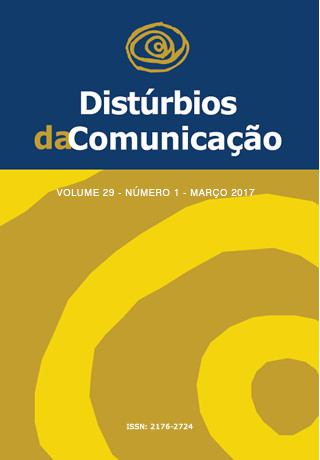Niños diagnosticados con síndrome de Irlen: análisis de producciones escritas
DOI:
https://doi.org/10.23925/2176-2724.2017v29i1p77-85Palabras clave:
Lenguaje, Fonoaudiología, SíndromeResumen
Este estudio tiene por objetivo analizar producciones escritas por un sujeto de 10 años de edad, de sexo masculino, diagnosticado con el Síndrome de Irlen (SI). Se trata un estudio de caso, investigación cualitativa, de carácter socio-histórico. Se ha priorizado el análisis de los aspectos discursivos y notacionales de las producciones escritas relacionadas con cuatro géneros discursivos: Una carta (a su ídolo, a un miembro de la familia o a un amigo), reglas de un juego, un cuento infantil y un póster. En cuanto a los aspectos discursivos, el participante de la investigación consiguió operar bajo diversos aspectos que caracterizan las condiciones de producción de los géneros requeridos, evidenciando pertinencia para los temas propuestos, la finalidad y el contexto de circulación del texto. En cuanto a los aspectos notacionales, el sujeto presentó estrategias y hipótesis distantes de la ortografía estandarizada, tales como: cambios, omisiones y adición de letras y segmentación inadecuada. Los resultados indican que los niños con este diagnóstico pueden desarrollar estrategias únicas en sus producciones, inherentes al proceso de apropiación de la lengua escrita. Ante el análisis realizado, se sugiere el implemento de estudios acerca del síndrome que ofrezcan elementos con los cuales profesionales de la salud y educación, involucrados con los individuos afectados, puedan en sus prácticas clínicas y escolares desarrollar un trabajo que da prioridad a los procesos y a las diferentes dimensiones relacionadas con la apropiación de la lectura y escritura.Descargas
Los datos de descargas todavía no están disponibles.
Métricas
Cargando métricas ...
Descargas
Publicado
2017-03-27
Número
Sección
Artigos
Licencia
Derechos de autor 2017 Ana Paula Belido, Ana Paula Berberian, Giselle Massi, Ingrid Mazzarotto, Rita Signor

Esta obra está bajo una licencia internacional Creative Commons Atribución 4.0.









